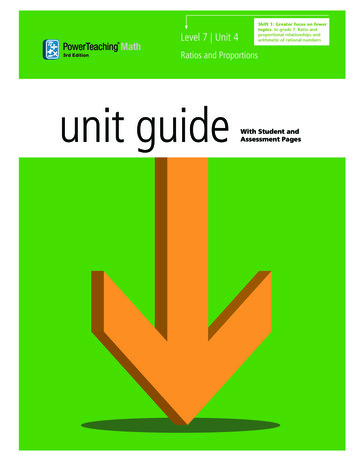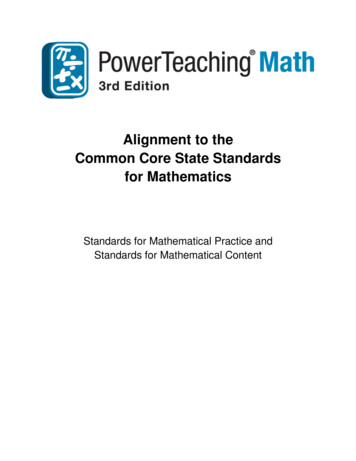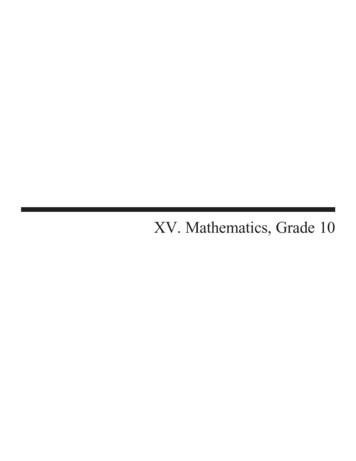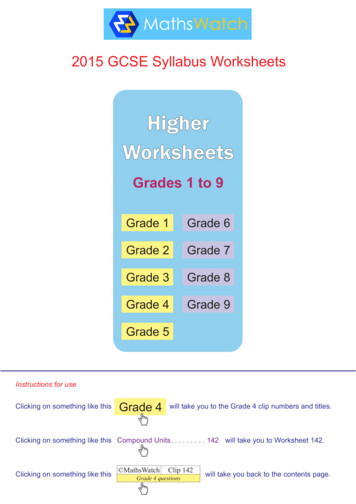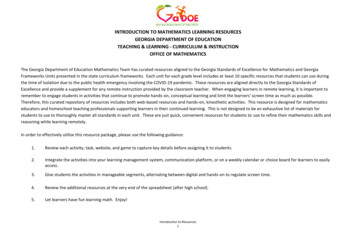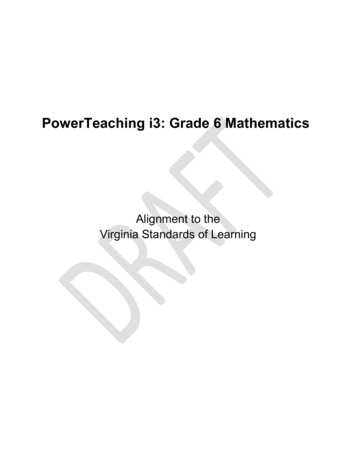
Transcription
PowerTeaching i3: Grade 6 MathematicsAlignment to theVirginia Standards of Learning
Section I: Alignment to the Standards of Learning: Five Goals for Math LearnersGrade 6Key Ideas and DetailsMathematical Problem SolvingThe PowerTeaching curriculum approaches problem solving in two ways: through specific problemsolving strategy lessons and through consistent practice with word problems and complex, real-worldproblem solving situations. Problem Solving Strategy—Students will learn a plan of attack when faced with problem-solvingsituations as well as specific strategies for special problem types such as finding a pattern orworking backwards. As each strategy is introduced, students will practice the strategies in currentand future math lessons. Word Problems—Throughout the lesson cycles, students will complete word problems, singleand multi-step, which relate to the math topics being discussed. This will provide opportunity todetermine which problem-solving strategies to use and to practice applying them. Constructed Response—Many PowerTeaching learning cycles culminate in a constructedresponse lesson. The math problems in these lessons are complex and combine multiplemath topics. Students will need to draw on their knowledge of math content and problem solvingstrategies in order to be successful in these lessons.Mathematical CommunicationThroughout the PowerTeaching curriculum, students will practice mathematical communication in twoways: orally and in written format. They will be encouraged to and rewarded for communicating incomplete sentences that include appropriate math vocabulary. Team Huddle—As a part of the daily PowerTeaching routine, students will complete TeamHuddle activities. During Team Huddle, students will actively communicate with their team tocomplete problems or answer questions. They must make sure each teammate understand theproblem, the answer, and how to explain their work. Random Reporter—Throughout each PowerTeaching lessons, students will randomly be pickedto share their answer to questions and to explain their thinking. Students’ answers will be ratedagainst the Random Reporter Rubric and should include the answer stated in a completesentence with a clear and precise explanation of how the student got the answer. Written Explanations—In each lesson cycle, at least on lesson requires students to explain theirthinking both orally and in written format. Think-Pair-Share—In each lesson of PowerTeaching, teachers will ask their students quickquestions to make sure they understand the teaching and modeling in the lesson. During ThinkPair-Share, students think about the answer to the question, pair and talk about their thinking withtheir partner, and then a few students are randomly selected to share their thinking with the class.Mathematical ReasoningSpecific targeted skills in the PowerTeaching curriculum address the topics of structure and patterns andhelp students see that reasoning and proof are the foundations of mathematics. They will also spend timein each lesson analyzing the reasoning of others.
Problem Solving Strategy: Look for a Pattern—Students will learn to identify problems that can besolved by finding and describing a pattern. They will learn how to represent the data to mostefficiently identify the pattern. In later lessons, students will apply this strategy to new and morecomplex problem solving situations. Expressions and Equations—Within the Expressions and Equations content area students willconsistently work to make sense of data by defining any patterns they notice and translatingthose patterns into expressions, equations, and graphs. Formulas and Mathematical Rules—In the PowerTeaching curriculum, students will be guidedthrough instruction, modeling, teamwork, and individual practice, to define rules and formulasbased on work with multiple examples. Instead of being given the rule, they will have to write therule, and then prove it by applying it to new situations. Get the Goof—Each lesson includes a Get the Goof activity. Students will discuss a completedproblem related to recently studied math topics. They will work with their teams to identify theerror in think that led to a mistake in the math work. The students will explain the error and correctthe math. Random Reporter—A part of the daily PowerTeaching routine includes teamwork and teamdiscussion to solve problems. At various points during each lesson, the teacher will use RandomReporter to have a student from each team share their answer and support that answer with theirteam’s reasoning.Mathematical RepresentationsStudents will use tables, graphs, charts and diagrams to represent mathematical information. They willalso use number sentences, expressions, and equations to describe a situation. Students will also usethe information they gather in tables, graphs, charts, and diagrams to identify patterns, determinerelationships, and draw conclusion. Problem Solving Strategy: Modeling—Students will receive specific and targeted instruction onmodeling as a strategy to solve math problems. Problem Solving Practice—The ongoing problem solving experiences, word problems,real-world scenarios, and constructed response, often require students to represent thedata as a model. Students must determine which model would best help them find thesolution or answer the question.Mathematical ConnectionsStudents will continually build their math skills in PowerTeaching. Through oral and written explanations,students will draw connections from the current skill to those they have previously mastered. In this way,students will also consistently review skills from earlier in the year or from previous school years withouttaking up additional class time. Similarly, when students complete constructed response lessons, they willdraw on skills from multiple content areas in order to solve the math problems.
Section II: Alignment to the Standards of Learning: Math ContentGrade 6Key Ideas and DetailsStandard of Learning 6.1: The student will describe and compare data, using ratios, and will useappropriate notations, such as a/b, a to b, and a:b.Unit 5 Cycle 1 Lesson 1—What Are Ratios?Objective: Write ratios in simplest form and explain what given ratios mean.Standard of Learning 6.2a: The student will investigate and describe fractions, decimals, and percentsas ratios.Unit 5 Cycle 1 Lesson 2—Ratios and TablesObjectives: Use tables to find equivalent ratios and compare different ratios.Unit 5 Cycle 1 Lesson 3—Rates and Unit RateObjective: Identify and write rates; find unit rates.Unit 5 Cycle 1 Lesson 4—Comparing RatesObjective: Compare two rates.Unit 6 Cycle 1 Lesson 2—Problem Solving with Unit RatesObjective: Students will solve unit rate problems.Unit 6 Cycle 1 Lesson 3—Graphing Equivalent RatiosObjective: Make tables of equivalent ratios and plot the values on a coordinate plane.Unit 6 Cycle 1 Lesson 4—Problem Solving with Ratios and Tape DiagramsStudents will solve multi-step ratio problems using tape diagrams.Unit 6 Cycle 1 Lesson 5—Ratio and Rate Problem SolvingObjective: Solve multi-step real-world problems involving rates and ratios.Unit 2 Cycle 2 Lesson 6—Adding and Subtracting DecimalsObjective: Add and subtract decimals beyond the thousandths place using the standard algorithm.Unit 2 Cycle 2 Lesson 7—Multiplying DecimalsObjective: Multiply decimals beyond the thousandths place using the standard algorithm.Unit 2 Cycle 2 Lesson 8—Dividing DecimalsObjective: Divide decimals beyond the thousandths place using the standard algorithm.Standard of Learning 6.2b: The student will identify a given fraction, decimal, or percent from arepresentation.Unit 3 Cycle 2 Lesson 4—Estimating the Value of FractionsObjective: Students will estimate the value of a fraction using the benchmarks 0, ½, and 1.Unit 2 Cycle 2 Lesson 5—Estimating with DecimalsObjective: Estimate the value of a decimal. Estimate sums, differences, products, and quotients ofdecimals beyond the thousandths.Unit 2 Cycle 2 Lesson 9—Decimal ComputationObjective: Solve multi-step word problems using decimal computation.
Unit 3 Cycle 3 Lesson 9—Problem Solving with Multiplying and Dividing FractionsObjective: Solve word problems using multiplication and division of fractions, whole numbers,and mixed numbers.Standard of Learning 6.2c: The student will demonstrate equivalent relationships among fractions,decimals, and percents.Unit 6 Cycle 2 Lesson 6—Understanding PercentsObjective: Represent parts of a whole as fractions, decimals, and percents, and convert betweenfractions, decimals, and percents.Standard of Learning 6.2d: The student will compare and order fractions, decimals, and percents.Unit 3 Cycle 2 Lesson 5—Ordering Fractions, Mixed Numbers, and DecimalsObjective: Students will order fractions, mixed numbers, and decimals.Unit 6 Cycle 2 Lesson 7—Comparing and Ordering Percents, Fractions, and DecimalsObjective: Students will compare and order percents, fractions, and decimals.Unit 6 Cycle 2 Lesson 8—Solving Percent ProblemsObjective: Solve one-step word problems involving percents.Unit 6 Cycle 2 Lesson 9—Problem Solving with PercentsObjective: Solve multi-step real-world problems involving percents.Standard of Learning 6.3a: The student will identify and represent integers.Unit 4 Cycle 1 Lesson 1—Exploring IntegersObjective: Use positive and negative integers to represent the solution to real-world situations.Standard of Learning 6.3b: The student will order and compare integers.Unit 4 Cycle 2 Lesson 4—Compare and Order IntegersObjective: Compare and order integers.Standard of Learning 6.3c: The student will identify the absolute value of integers.Unit 4 Cycle 2 Lesson 5—Absolute ValueObjective: Identify the absolute value of rational numbers.Unit 4 Cycle 2 Lesson 6—Problem Solving with CoordinatesObjective: Students will be able to problem solve using coordinates.Standard of Learning 6.4: The student will demonstrate multiple representations of multiplication anddivision of fractions.Unit 3 Cycle 1 Lesson 1—Greatest Common FactorObjective: Find the greatest common factor for two numbers.Unit 3 Cycle 1 Lesson 2—LCMObjective: Find the least common multiple of two numbers.Unit 3 Cycle 1 Lesson 3—Problem Solving with GCF and LCMObjective: Find the GCF and/or LCM to solve word problems.
Unit 3 Cycle 2 Lesson 6—Multiplying with Fractions and Mixed NumbersObjective: Students will multiply with fractions and mixed numbers.Unit 3 Cycle 3 Lesson 7—Divide Whole Numbers by FractionsObjective: Divide whole numbers by fractions and mixed numbers.Unit 3 Cycle 3 Lesson 8—Divide Fractions by FractionsObjective: Students will divide fractions by fractions.Standard of Learning 6.5: The student will investigate and describe concepts of positive exponents andperfect squares.Unit 7 Cycle 1 Lesson 1—Understanding ExponentsObjective: Use real-world examples, such as area and arrays, to understand and simplify exponents.Standard of Learning 6.6a: The student will multiply and divide fractions and mixed numbers.Unit 3 Cycle 2 Lesson 6—Multiplying with Fractions and Mixed NumbersObjective: Students will multiply with fractions and mixed numbers.Unit 3 Cycle 3 Lesson 7—Divide Whole Numbers by FractionsObjective: Divide whole numbers by fractions and mixed numbers.Unit 3 Cycle 3 Lesson 8—Divide Fractions by FractionsObjective: Students will divide fractions by fractions.Standard of Learning 6.6b: The student will estimate solutions and then solve single-step and multisteppractical problems involving addition, subtraction, multiplication, and division of fractions.Unit 3 Cycle 2 Lesson 4—Estimating the Value of FractionsObjective: Students will estimate the value of a fraction using the benchmarks 0, ½, and 1.Unit 3 Cycle 3 Lesson 9—Problem Solving with Multiplying and Dividing FractionsObjective: Solve word problems using multiplication and division of fractions, whole numbers,and mixed numbers.Standard of learning 6.7: The student will solve single-step and multistep problems involving addition,subtraction, multiplication, and division of decimals.Unit 2 Cycle 2 Lesson 5—Estimating with DecimalsObjective: Estimate the value of a decimal. Estimate sums, differences, products, and quotients ofdecimals beyond the thousandths.Unit 2 Cycle 2 Lesson 9—Decimal ComputationObjective: Solve multistep word problems using decimal computation.Standard of Learning 6.8: The student will evaluate who number numerical expressions using the orderof operations.Unit 2 Cycle 1 Lesson 1—Mental MathObjective: Use mental math strategies for multiplication and division.Unit 2 Cycle 1 Lesson 2—EstimationObjective: Estimate products and quotients; determine if an estimate or exact answer is more appropriate.Unit 2 Cycle 1 Lesson 3—Whole Number Division 1Objective: Use the standard algorithm to divide multi-digit whole numbers.
Unit 2 Cycle 1 Lesson 4—Whole Number Division 2Objective: Divide multi-digit numbers using the standard algorithm and show remainder inappropriate forms.Unit 7 Cycle 1 Lesson 2—Order of OperationsObjective: Use the Order of Operations to simplify numeric expressions with the four operations,parentheses, and exponents.Unit 7 Cycle 1 Lesson 3—Write and Evaluate Numeric ExpressionsObjective: Given a real-world problem or math story, write and find the value of the numeric expression.Standard of Learning 6.9: The student will make ballpark comparisons between measurements in theU.S. Customary System of measurement and measurements in the metric system.Unit 6 Cycle 1 Lesson 1—Converting MeasurementsObjective: Convert a measurement of one unit to a measurement of another unit, and determine theconversion rate of two equivalent measures.Unit 12 Cycle 1 Lesson 4—Convert Metric Units of MeasureObjective: Convert metric units of measure using ratio reasoning as well as multiplication and division bymultiples of 10.Unit 12 Cycle1 Lesson 5—Convert Customary Units of MeasureObjective: Convert customary units of measure using ratio reasoning; conversions will require multiplesteps (e.g. converting from fluid ounces to gallons).Unit 12 Cycle 1 Lesson 6—Measurement in Problem SolvingObjective: Solve multi-step, real-world problems involving measurements including conversion ofmeasurements and adding, subtracting, multiplying, and dividing measurements.Standard of Learning 6.10a: The student will define pi as the ratio of the circumference of a circle to itsdiameter.This skill is in the grade 7 curriculum of PowerTeaching.Standard of Learning 6.10b: The student will solve practice problems involving circumference and areaof a circle, given the diameter or radius.This skill is in the grade 7 curriculum of PowerTeaching.Standard of Learning 6.10c: The student will solve practical problems involving area and perimeter.Unit 12 Cycle 2 Lesson 8—Area of Rectangles and TrianglesObjective: Review the formula for area of a rectangle. Derive the area of a triangle from the area of arectangle.Unit 12 Cycle 2 Lesson 9—Area of QuadrilateralsObjective: Find the area of special quadrilaterals (parallelogram, trapezoid, and rhombus) by composingrectangles or decomposing into rectangles and/or triangles.Unit 12 cycle 2 Lesson 10—Area on the Coordinate PlaneObjective: Find the area of rectangles, triangles, and special quadrilaterals on the coordinate plane.Standard of Learning 6.10d: The student will describe and determine the volume and surface area of arectangular prism.
Unit 13 Cycle 1 Lesson 1—Find Volume 1Objective: Estimate the volume of a container/object shaped like a rectangular prism in unit cubes. Thenfind the actual measure in unit cubes.Unit 13 Cycle 1 Lesson 2—Derive the FormulaObjective: Derive the formula for volume (V lwh) by making a data table that includes the volume,length, width, and height of a rectangular prism in unit cubes.Unit 13 Cycle 1 Lesson 3—Find the Volume 2Objective: Estimate and find the volume of rectangular prisms using the formulas for volume (V lwh andV Bh).Unit 13 Cycle 1 Lesson 4—Volume and Problem SolvingObjective: Solve real-world problems related to volume.Unit 13 Cycle 2 Lesson 5—Solid Figures and NetsObjective: Name a solid figure when given its net. Construct/draw a net to represent a given solid figure.Unit 13 Cycle 2 Lesson 6—Surface area of Rectangular Prisms and Triangular PrismsObjective: Draw or construct nets of triangular and rectangular prisms and label the measures of thesides. Find the area of each face to find the surface area of the figure then use surface area calculationsto determine how to find surface area of triangular and rectangular prisms without the net.Unit 13 Cycle 2 Lesson 7—Surface area of PyramidsObjective: Draw or construct nets of triangular and rectangular pyramids and label the measures of thesides. Find the area of each face to find the surface area of the figure then use surface area calculationsto determine how to find surface area of triangular and rectangular pyramids without the net.Unit 13 Cycle 2 Lesson 8—Problem Solving with Surface AreaObjective: Use nets and/or processes to find the surface area in order to solve real-world problems.Standard of Learning 6.11a: The student will identify the coordinates of a point in a coordinate plane.Unit 4 Cycle 1 Lesson 2—Graphing Ordered Pairs in All QuadrantsObjective: Locate and plot points in all quadrants of a coordinate plane.Standard of Learning 6.11b: The student will graph ordered pairs in a coordinate plane.Unit 4 Cycle 1 Lesson 2—Graphing Ordered Pairs in All QuadrantsObjective: Locate and plot points in all quadrants of a coordinate plane.Unit 4 Cycle 2 Lesson 6—Problem Solving with CoordinatesObjective: Students will be able to problem solve using coordinates.Standard of Learning 6.12: The student will determine congruence of segments, angles, and polygons.This skill is in the grade 8 curriculum of PowerTeaching.Standard of Learning 6.13: The student will describe and identify the properties of quadrilaterals.Unit 12 Cycle 2 Lesson 7—Properties of PolygonsObjective: Explore the properties of various polygons (triangles, quadrilaterals, etc.). Define a polygon byits properties and identify polygons by sight and description.Standard of Learning: 6.14: The student will a) construct circle graphs, b) draw conclusions and makepredictions using circle graphs, and c) compare and contrast graphs that present information from the
same data set.Unit 14 Cycle 1 Lesson 1—Collecting DataObjective: Student teams work to gather and organize data for a given statistical question using theproper data gathering techniques.Unit 14 Cycle 1 Lesson 2—Variability and Statistical QuestionsObjective: Analyze the results from the data surveys and identify any variability in the data. Discuss theimportance of statistical data.Unit 14 Cycle 1 Lesson 3—Writing Statistical QuestionsObjective: Write statistical questions about topics of interest then use the questions to gather and analyzeadditional data.Unit 14 Cycle 2 Lesson 4—Displays of Categorical DataObjective: Define categorical data and display the data on bar graphs, circle graphs, and stem-and-leafplots. Analyze given categorical data.Unit 14 Cycle 2 Lesson 6—Line GraphsObjective: Understand what makes line graphs a special type of numerical data. Identify data appropriatefor a line graph and analyze data given in a line graph.Unit 14 Cycle 2 Lesson 7—HistogramsObjective: Create histograms from given data.Unit 15 Cycle 1 Lesson 3—Box PlotsObjective: Create box plots when given a simple data set.Unit 15 Cycle 1 Lesson 1—Shapes of Data SetsObjective: Use the shape of a data set to describe the data set. Compare different graphs for the samedata set or for different data sets.Unit 15 Cycle 1 Lesson 2—Numerical Data SetsObjective: Describe the data set depicted on a histogram by analyzing its shape, center, and spread.Unit 15 Cycle 1 Lesson 4—Comparing Box PlotsObjective: Describe a data set depicted on a box plot by analyzing its shape, center, and spread.Standard of Learning 6.15a: The student will describe mean as a balance point.Unit 15 Cycle 2 Lesson 5—Measures of Center 1Objective: Understand mean, median, and mode and how to calculate each. Use these measures ofcenter to answer questions about a data set.Standard of Learning 6.15b: The student will decide which measure of center is appropriate for a givenpurpose.Unit 15 Cycle 2 Lesson 6—Measures of Center 2Objective: Understand and predict how measures of center will change when a data set changes, usegiven measures of center to describe a data set, and determine which measure of center is best todescribe given data sets.Standard of Learning 6.16a: The student will compare and contrast dependent and independent events.Unit 11 Cycle 1 Lesson 1—Dependent and Independent RelationshipsObjective: Establish and understand the definition for dependent and independent events and variables.Decide whether given events/variables are dependent on independent.
Unit 11 Cycle 1 Lesson 2—Patterns and Number TablesObjective: Name the mathematical relationship between x and y of a given number table and express itas an algebraic expression.Unit 11 Cycle 1 Lesson 3—Dependent and Independent DataLook at data in a table that represents a real-world situation; name the dependent and independentvariable then describe the relationship between the two variables.Standard of Learning 6.16b: the student will determine probabilities for dependent and independentevents.This skill is in the grade 7 curriculum of PowerTeaching.Standard of Learning 6.17: The student will identify and extend geometric and arithmetic sequences.Unit 5 Cycle 1 Lesson 5—Find a PatternObjective: Solve word problems by finding and extending patterns. Students will use the geometric,numeric, or algebraic patterns to make predictions about future events.Standard of Learning 6.18: The student will solve one-step linear equations in one variable involvingwhole number coefficients and positive rational solutions.Unit 7 Cycle 2 Lesson 4—Introduction to VariablesObjective: Understand that variables are letters used to represent unknown quantities in a math situation.Unit 7 Cycle 2 Lesson 5—Algebraic Expressions and VocabularyObjective: Understand the vocabulary associated with algebraic expressions: variable, constant, term,and coefficient. Identify those terms as parts of algebraic expressions.Unit 7 Cycle 2 Lesson 6—Writing Expression 1Objective: Write one-step algebraic expressions to represent math statements with variables.Unit 7 Cycle 2 Lesson 7—Writing Expression 2Objective: Write multi-step algebraic expressions to represent math statements with variables.Unit 7 Cycle 3 Lesson 8—Evaluate Expressions 1Objective: Evaluate single- and multi-step expressions at specific values of the variable.Unit 7 Cycle 3 Lesson 9—Evaluate Expressions 2Objective: Use geometric formulas to explore algebraic expressions with exponents. Then evaluate theexpressions for given values.Unit 7 Cycle 3 Lesson 10—Expressions and PatternsObjective: Use a table of values to determine how changing the value of the variable affects the value ofthe expression and make predictions based on observations from the table.Unit 7 Cycle 3 Lesson 11—Write and Evaluate ExpressionsObjective: Write an expression to represent a real-world situation. Then evaluate the expression at aspecific value.Unit 9 Cycle 1 Lesson 1—Defining EquationsObjective: Understand that the two sides of an equation are equal and balanced. Use objects andnumeric expressions to make equations.Unit 9 Cycle 2 Lesson 6—Inverse OperationsObjective: Define and identify inverse operations. Use inverse operations to solve equations equalto zero.
Unit 9 Cycle 2 Lesson 7—Solving Addition and Subtraction EquationsObjective: Use inverse operations to solve one-step addition and subtraction equations withwhole numbers.Unit 9 Cycle 2 Lesson 8—Solving Multiplication and Division EquationsObjective: Use inverse operations to solve one-step multiplication and division equations withwhole numbers.Unit 9 Cycle 2 Lesson 9—Solve Equations to Answer QuestionsObjective: Solve a given one-step equation to answer a real-world math problem.Unit 9 Cycle 3 Lesson 10—Choose the Correct Equation 1Objective: Given a choice of three equations, choose the one that correctly represents the additionor subtraction situation.Unit 9 Cycle 3 Lesson 11—Choose the Correct Equation 2Objective: Given the choice of three equations, choose the one that correctly represents the multiplicationor division situation.Unit 9 Cycle 3 Lesson 12—Write and Solve EquationsObjective: Write an equation to represent a real-world problem. Then solve the equation to answer theproblem’s question.Unit 11 Cycle 2 Lesson 4—Tables and Equations 1Objective: Make a table of values from a linear equation. Use a table of values to write an equation.Unit 11 Cycle 2 Lesson 5—Tables and Equations 2Objective: Use a table of values to understand and write the formulas for area and perimeter of rectanglesand volume of a rectangular prism.Unit 11 Cycle 2 Lesson 6—Tables and GraphsObjective: Use a table of values to graph a relationship between two variables. Use the graph to describethe relationship between the two variables.Unit 11 Cycle 2 Lesson 7—Linear RelationshipsObjective: Given a real-world situation, make a table of values, write an equation, and graph therelationship of the two variables.Standard of Learning 6.19: The student will investigate and recognize a) the identity properties foraddition and multiplication, b) the multiplicative property of zero, and c) the inverse property formultiplication.Unit 8 Cycle 1 Lesson 1—Properties of Addition 1Objective: Identify the Properties of Addition and use them to rewrite and simplify numeric expressions.Unit 8 Cycle 1 Lesson 2—Properties of Addition 2Objective: Use the Properties of Addition to make equivalent expressions with variables.Unit 8 Cycle 2 Lesson 5—Properties of Multiplication 1Objective: Identify the Properties of Multiplication and use them to rewrite and simplify numericexpressions.Unit 8 Cycle 2 Lesson 6—Properties of Multiplication 2Objective: Use the Properties of Multiplication to make equivalent expressions with variables.Unit 8 Cycle 2 Lesson 7—Greatest Common Factor in ExpressionsObjective: Find the greatest common factor of two algebraic terms.
Unit 8 Cycle 2 Lesson 8—The Distributive PropertyObjective: Use the Distributive Property to rewrite algebraic expressions with variables.Unit 8 Cycle 1 Lesson 4—Proving Expressions Equivalent 1Objective: Evaluate two expressions and determine whether they are equivalent. Then use the Propertiesof Addition to describe why they are equivalent.Unit 8 Cycle 2 Lesson 9—Proving Expressions Equivalent 2Objective: Evaluate two expressions and determine whether they are equivalent. Then use the Propertiesof Multiplication to describe why they are equivalent.Standard of Learning 6.20: The student will graph inequalities on a number line.Unit 10 Cycle 1 Lesson 1—Equations and InequalitiesObjective: Understand the differences between equations and inequalities.Unit 10 Cycle 1 Lesson 2—Graphing InequalitiesObjective: Graph simple inequalities, such as x 4, on a number line. Then answer questions about theinequality and its graph.Unit 10 Cycle 1 Lesson 3—Write and Graph InequalitiesObjective: Write simple inequalities to represent real-world problems. Then graph the inequalities on anumber line to find possible solutions.Unit 10 Cycle 1 Lesson 4—Solutions to InequalitiesObjective: Substitute given values for the variable in a one-step inequality, such as x – 4 7, to determineif they are a possible solution.Unit 10 Cycle 1 Lesson 5—Use number sense and guess-and-check to define a solution set for a onestep inequality.
The math problems in these lessons are complex and combine multiple math topics. Students will need to draw on their knowledge of math content and problem solving . questions to make sure they understand the teaching and modeling in the lesson. During Think-Pair-Share, students think about the answer to the question, pair and talk about their .
